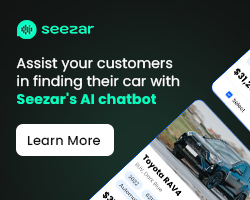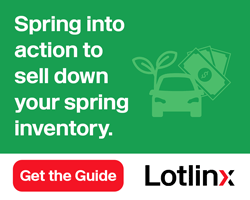Website Buttons… and why in the world are you letting self-appointed “experts” screw everything up?
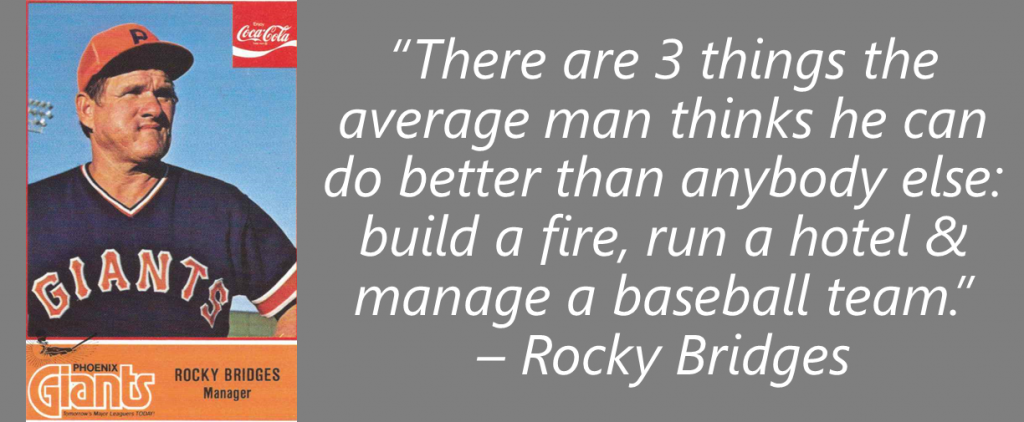
There are two quotes from baseball’s late, great Rocky Bridges that I just love:
“Albuquerque: You can’t spell it, but you can smell it.”
and
“There are three things the average man thinks he can do better than anybody else: build a fire, run a hotel and manage a baseball team.”
The first quote doesn’t really apply to this article; I just think it’s pretty funny and that it should never be forgotten.
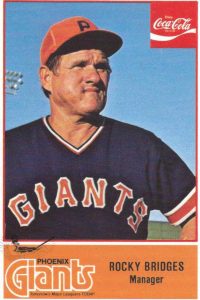
The second quote, however, does help me make my point. If Rocky were to update that quote today, he would likely include “design a website” as one of the three things the average man thinks he can do better than anyone else.
Let’s settle this right now: The average man (or woman) cannot effectively design a website to save his (or her) own life. I’m sorry, they simply cannot. No matter how smart they think they are or how keen their eye for color and contrast, there is simply too much that goes into an effective website design for the average Joe or Jill to do much beyond screwing things up. (Editor’s Note: Just ask the GST dealers right now…)
And that’s where many of you are today. Your internet manager, digital marketing manager, new car sales manager, ad agency and/or some other website “expert” has put their dirty little hands on your website’s design and now it’s no longer delivering on one or both of its only goals:
- Attract Visitors
- Convert those Visitors into Buyers
Stop Underestimating Your Buttons!
We’re not going to solve everything that’s potentially wrong with your website in one post (though we’ll get close with my 21-part free video series on website conversion design), so let’s work on something extremely important that can often be both the easiest component of conversion design to screw up and the easiest component to fix – your buttons!
Conversion design, for the average man or woman, refers to the process of designing a website to maximize leads, calls and sales – that is, conversions.
One common issue with about a third of the car dealer websites I review is that their conversion buttons appear to be taken for granted. That is, they have only one or two buttons on their SRPs (Search Results Pages) and the same one or two buttons on their VDPs (Vehicle Details Pages) complete with confusing or weak calls-to-action like “Price Watch” or “Get Directions.”

Clearly, the dealers using these as their primary lead-driving buttons have underestimated how powerful great conversion buttons can be – they are taking their buttons for granted.
To ensure you’re not underestimating your buttons, you’ll want to complete a quick review of your VDPs and SRPs. When reviewing the conversion buttons on these pages, you’ll need to run them through three quick tests:
- Do your buttons make site visitors aware of something important to you?
- Do they make these visitors want to take an action (i.e., click the button)?
- Do the buttons make the visitor want to convert (i.e., complete a web form)?
Buttons, when done right, drive leads; and the right buttons don’t get ignored. Stop underestimating your buttons.
Stop Overthinking Your Buttons!
Another third of the dealer websites I visit have the opposite problem. Instead of underestimating their buttons, they’re over thinking them. For example, we mystery shopped a dealer this week via their “Schedule A Test Drive” button. Great, right? Nope, not so much.
Not only was this the ONLY conversion button on their SRPs & VDPs, but when we selected the button it opened a standard form that had no option for selecting a date or time for the test drive. Begging the question: How is a consumer supposed to schedule a test drive when your form won’t let them schedule a test drive?
So, how did this become the sole conversion button on this dealer’s website? My guess would be that:
- The GM was probably tired of the BDC asking about ePrices with every lead, so they removed the “Get ePrice” button.
- The BDC Manager wanted his/her team to focus on setting more appointments, so he/she thought “let’s make a button for that.”
- To ensure that the focus was solely on test drive appointments, he/she removed the rest of the conversion buttons from the VDP.
That’s called overthinking your buttons!
Based on our studies, the optimal number of conversion buttons on a vehicle listing on your SRP is three. Coincidentally, that’s also the optimal number of conversion buttons on your VDPs. Optimal meaning where you generate the most leads per 100 visitors.
Great Steve! Now, Which Three Buttons Work Best?
Well, that is the question, isn’t it? The truth is that you can use a number of different buttons and enjoy roughly the same number of leads, so long as you follow two rules:
- Use different buttons on your VDPs than you do on your SRPs. Why? Because, if a given button didn’t trigger a lead on the SRP, what makes you think it will do so on the VDP?
- Ensure your three buttons include one low commitment button, one medium commitment button and one high commitment button. Why? Because, consumers are different and in different parts of the sales funnel when they visit your site. While one consumer might be willing to give you their social security number, another might not even want you to know their email address.
When I write about low, medium and high commitment buttons, I am referring to what the consumer thinks when they read a given button’s call-to-action. “Am I going to have to trade lots of my information for whatever that button promises?”
High commitment buttons, therefore, include:
- Buy It Now
- Start My Deal
- Apply For Financing
- Lock-In My Price
- Text Us
- Make An Offer
For all of the examples above, most consumers will determine that there is a considerable amount of information sharing and even dealership interaction required if they click through.
Medium commitment buttons include:
- Let’s Chat
- Credit Score Estimator
- Schedule Test Drive
- Get Price Alerts
- Personalize Payments
- Value My Trade
- Request More Information
- Contact/Email Us
These buttons, you see, tell the consumer that there will be some dealership interaction required, but that it might be possible to stay relatively anonymous (giving up their email address, at most).
Low commitment buttons include:
- Check Availability
- Verify First
- Get ePrice
- Calculate Payments
- Share This Vehicle
- Save This Vehicle
These are considered low commitment buttons because the consumer assumes (incorrectly) that they’re going to click a button and receive some information without having to share any of their personal information.
Okay Steve, But What Are My Next Steps?
The key now is to pick one button from each category for your SRPs and a different button from each category for your VDPs. Get your website company to put these in place, and connect them to the right forms. For example, if your button reads “Schedule a Test Drive” then make sure the consumer can do exactly that.
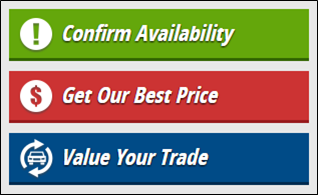
Now wait. Track and measure for at least 30 days and then practice something called continuous process improvement. This means you’ll want to choose one (not all six) of the original buttons and replace it with a different button of the same commitment level.
Now wait again. Track and measure for at least 30 days; then repeat over and over again until you’ve run through every possible button combination and you’re certain your site is delivering the maximum conversion rate possible.
Great Steve! Does This Mean I’m An Expert Now?
Nope, not even close. However, if you’re willing to always remember your website’s two goals (attract & convert) and then weigh every “expert” opinion, and new gadget, widget and parasite against those goals, you’ll be a lot less likely to screw everything up and a whole lot more likely to generate conversions at a rate much higher than any of your competitors.
Good selling!




